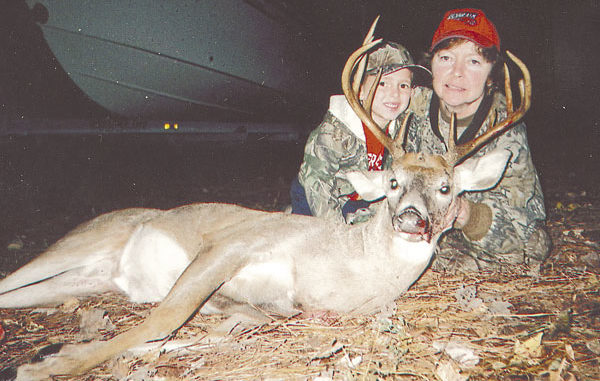
This Wake Forest hunter carried a big horseshoe last season, but her success was due to strong tactics rather than luck.
Linda Draheim believes the best way to catch a husband and become a deer hunter is to become a raccoon hunter.
“It was 31 years ago in New York, where I’m from. My sister had a guy friend — not a boyfriend — and while they were talking one day, he asked if she wanted to go coon hunting with him,” she said. “I said, ‘I want to go … take me, take me.’
”She went on the coon-hunting expedition with Keith Draheim, later married him. They started hunting deer and turkeys together and have been ever since.
“After he saw how much I enjoyed the coon hunting, he said, ‘I’ve gotta marry this gal,’” she said, laughing.
After moving to North Carolina several years ago, the two began intensely hunting the Tarheel State and Virginia, and they always make a winter trip back to New York to hunt whitetails.
Last year, they not only put 13 bucks on the ground, but a 9-pointer Linda Draheim killed in November scored 135 6/8 Boone & Crockett points and was the top blackpowder buck killed by a female hunter at the 2010 Dixie Deer Classic.
And the week before she killed her big North Carolina buck, she used her .50-caliber Thompson-Center Black Diamond muzzleloader to drop an 11-point buck in Virginia that scored in the high 130s.
“Last year I killed seven bucks — one in New York, three in Virginia and three in North Carolina — and my husband, Keith, killed six,” she said.
Linda Draheim, 56, who had never hunted before meeting her husband-to-be, also became the first licensed female turkey-hunting guide in New York in 2002.
Today, living in Wake Forest, she operates a house-cleaning business in Wake County, while her husband drives a truck for a local concrete company. The rest of the time, they think about and prepare for deer seasons in the three states.
“I don’t guide in North Carolina,” she said. “I’ve taken a few people out for turkeys and deer, but it’s not a job or anything like that. Keith did (guide) deer, goose and turkey hunts in New York. We have some land (in Virginia and New York), plus we lease some land.”
Linda Draheim killed a spike buck on the first day of muzzleloader season in Virginia last year, added the 11-pointer a week later, then downed the 9-pointer in North Carolina on the last day of muzzleloader season.
“I also killed a 3-point buck with a rifle in North Carolina, then another spike with a rifle and went to New York and shot a 6-pointer with a rifle,” she said.
All that venison doesn’t go to waste.
“We have so many people that my husband works with who love venison, and friends and neighbors who love to eat deer meat,” she said. “We don’t have any trouble giving away venison.”
Linda Draheim even gave one of her deer to a cashier she met at Wal-Mart.
“I was checking out, and I must have seemed to be in a hurry, I guess, because the girl asked me why, and I said I had to get in the woods soon because me and my husband were hunting deer that afternoon,” she said. “The girl said, ‘Oh, I love deer meat.’ So we have ended up giving her three or four of the deer we’ve killed.
“Keith makes deer-burger patties and deer sausage and takes him to work and gives it away to his co-workers, too.”
The Draheims always plan their hunts near the time of the mating season, or “rut,” in the three states.
“Deer always seem to be moving more during the rut, especially the bucks, no matter where we go,” she said. “That’s why we like hunting with blackpowder because the season coincides with the rut in North Carolina and Virginia.”
Because of warm weather in 2009, the rut period in New York also seemed to coincide with the days they hunted in the Empire State.
Linda Draheim said last year that North Carolina bucks were “cruising” a lot during the pre-rut, which also is a good time to be in the woods.
“The pre-rut is almost like a magnet,” she said. “A lot of times when the New York season comes in it’s after the rut, but because it was so warm last year up there and so late in the year, the same thing happened up there as happened in North Carolina during the rut. Deer were on the move when we went.
“The 9-pointer was moving, pawing in the leaves and hitting every tree in the vicinity it seemed,” she said. “I think he was marking his territory. He was looking and smelling the ground, too.”
Linda Draheim and her husband do a lot of preseason scouting, looking for trails and rub lines, but they don’t stay in their hunting areas once they discover buck sign.
They also take care not to hunt where other hunters normally set up their stands. They use climbing stands in order to be as mobile as possible.
“We don’t hunt field edges at all, because that’s where most other people scout and hunt,” she said. “But we’re definitely after big bucks, and we’ve found we have better luck hunting as deep in the woods as we can — and the thicker the territory the better.
“That’s where we always find bigger bucks — along the edges of thickets and swamps. Everybody else scouts and hunts around field edges, and that means other hunters have seen those deer. We’ve also found smaller bucks and does hang out at those places, but the larger ones don’t.”
The award-winning 9-pointer was a perfect example of that.
She had put up a climbing stand near a small creek and a thicket.
“I got to my stand late, probably 3:30,” she said. “My husband had gotten off work early and decided to go early, and I said, ‘Okay, I’ll go with you.’ ”
“There wasn’t any farmland there, just the thicket, bedding areas and scrapes,” she said. “There was a rub line nearby, but I was about 100 yards from the thicket.”
Before she put her stand about 20 feet up in a pine tree, Linda Draheim also made sure the wind was coming from the right direction and wouldn’t blow her scent into the thicket deer were using as a bedding area.
“I’d probably sat in the stand for an hour or a little more, because I think it was about 4:30 or 5 p.m. when I saw this buck cross a low place with some cattails about 75 yards in front of me,” she said.
Linda Draheim immediately got the shakes, buck fever.
“It was maybe a half-hour before dark, a perfect time,” she said. “It was quiet, and I caught sight of his antlers out of the corner of my eye when I heard the cattails rustling.”
Then, the buck walked into the thicket, and her racing heart skipped a beat, because she at first thought she’d seen the last of this buck with a high, white rack of antlers.
“I went ‘Oh, my gosh,’ ” she said.
She was hoping he would cross in an opening in the thicket, but he didn’t. However, the buck suddenly walked out of the thicket and started ambling straight toward her.
“I had my muzzleloader up and was looking through the scope, but he was walking right at me, and I didn’t want to take a chance on that shot,” Linda Draheim said. “He kept getting behind bushes and trees. He was rubbing his antlers on them, but he kept coming at me, so I tried to calm myself, but I was shaking. Usually, I don’t get so nervous.”
Finally the buck turned, offering a quartering shot at 25 yards, and Draheim pulled the trigger, sending a .50-caliber saboted bullet through its left shoulder.
“He jumped up in the air, charged straight at me and fell 10 steps from my tree,” she said.
Linda Draheim, who also has killed whitetails with a bow, said she was excited as she ever had been as she looked at the big buck.

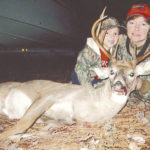
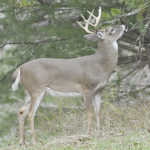
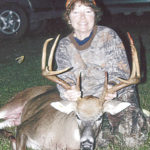
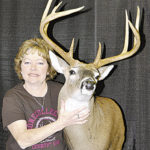



Be the first to comment